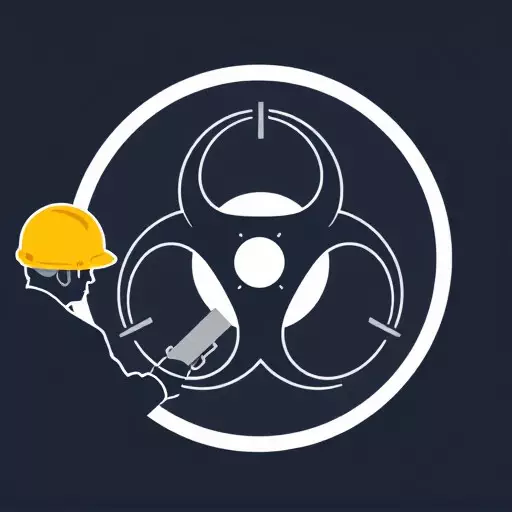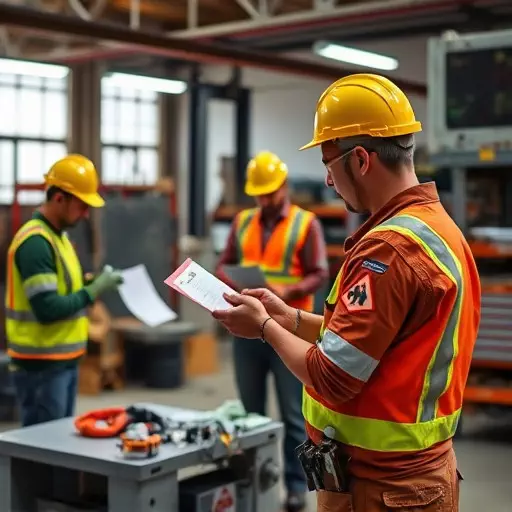Hazard identification training is a critical component of workplace safety, empowering employees to recognize and mitigate risks according to OSHA guidelines. This proactive approach reduces accidents, injuries, legal repercussions, and improves morale and productivity. Effective hazard identification programs involve interactive risk assessments, data-driven methods, and regular updates to industry standards, using tools like checklists and scenario-based learning on digital platforms. Measuring success through incident rate reductions and employee feedback ensures training effectiveness and OSHA compliance.
Hazard identification training is a fundamental aspect of workplace safety, empowering employees to recognize and mitigate risks. This comprehensive guide explores OSHA compliance training, essential for every organization to ensure worker well-being and legal adherence. We break down key components, provide step-by-step strategies for identifying common hazards, and offer risk assessment techniques. Additionally, we discuss effective training methods, tools, and evaluation metrics to maximize the impact of hazard identification training in your workplace.
- Understanding Hazard Identification Training: A Cornerstone of Workplace Safety
- The Importance of OSHA Compliance in Hazard Management
- Key Components of Effective Hazard Identification Programs
- Identifying Common Workplace Hazards: A Step-by-Step Guide
- Implementing Risk Assessment Techniques for Comprehensive Hazard Analysis
- Training Methods and Tools to Enhance Employee Awareness
- Measuring Success: Evaluating the Impact of Hazard Identification Training
Understanding Hazard Identification Training: A Cornerstone of Workplace Safety

Hazard identification training is a fundamental aspect of workplace safety, serving as a cornerstone for creating safer and more compliant work environments. This essential training equips employees with the knowledge and skills to recognize potential hazards in their daily tasks and operations. By understanding OSHA’s (Occupational Safety and Health Administration) guidelines on hazard identification, organizations can ensure they’re meeting compliance standards while fostering a culture of proactive safety measures.
Effective hazard identification training involves interactive sessions where workers learn to assess risks, interpret safety data, and implement preventive measures. It encourages a mindset shift from reactive to proactive safety, enabling employees to identify and mitigate potential dangers before they escalate. This proactive approach not only reduces the risk of accidents and injuries but also helps organizations avoid costly fines and legal repercussions associated with OSHA non-compliance.
The Importance of OSHA Compliance in Hazard Management

In today’s world, where workplace safety is a paramount concern, adhering to OSHA (Occupational Safety and Health Administration) standards is not just a legal requirement but an essential pillar for any organization prioritizing its employees’ well-being. OSHA compliance training plays a pivotal role in hazard management by equipping workers with the knowledge to recognize potential risks and implement effective mitigation strategies. This proactive approach fosters a culture of awareness, ensuring that even the subtlest hazards are identified and addressed before they escalate into safety incidents.
The benefits extend beyond legal liability; OSHA-compliant workplaces tend to have lower accident rates, improved employee morale, and enhanced productivity. Effective hazard identification training, integrated with ongoing OSHA compliance updates, keeps work environments safe, efficient, and in accordance with established health and safety guidelines. This commitment to workplace safety not only protects employees but also builds a positive reputation for the organization, attracting and retaining talent in an increasingly safety-conscious job market.
Key Components of Effective Hazard Identification Programs

Effective hazard identification programs are built on several key components that drive workplace safety training and osha compliance training initiatives. Firstly, they foster a culture of proactive risk assessment where employees at all levels actively participate in recognizing potential dangers within their work environment. This involves regular meetings and workshops designed to encourage open dialogue about safety concerns. Secondly, these programs leverage data-driven methods to identify hazards systematically. By analyzing incident reports, conducting inspections, and incorporating feedback from workers, organizations can pinpoint specific risks associated with tasks, equipment, or facilities.
Moreover, successful hazard identification strategies emphasize the importance of training in risk assessment tools and methodologies. Equipping employees with the knowledge to conduct thorough assessments enables them to identify not only obvious hazards but also subtle risks that might be overlooked. Regular updates on industry standards and best practices ensure that safety protocols remain current and relevant, aligning workplace safety training with evolving regulatory requirements for osha compliance training.
Identifying Common Workplace Hazards: A Step-by-Step Guide

Identifying common workplace hazards is a crucial step in ensuring OSHA compliance and providing comprehensive workplace safety training. The process begins with a thorough assessment of the work environment, considering every aspect from physical spaces to equipment operations. It’s essential to involve employees at this stage, as they often possess unique insights into potential risks. Create checklists tailored to specific job roles or departments to ensure nothing is overlooked—from slip-and-fall risks due to floor conditions to machine safety for operators. Regular inspections should be conducted to update these checklists, as hazards can evolve over time.
A step-by-step guide would start by categorizing hazards into physical, chemical, biological, and ergonomic categories. Next, conduct a risk assessment for each identified hazard, evaluating the likelihood and severity of potential injuries or illnesses. Prioritize addressing high-risk items first, implementing preventive measures such as engineering controls, administrative controls, or personal protective equipment (PPE). Regularly update training materials to reflect new or modified hazards, ensuring all employees are equipped with the knowledge to recognize and mitigate risks in their respective roles, thereby fostering a safer work environment.
Implementing Risk Assessment Techniques for Comprehensive Hazard Analysis

Implementing effective risk assessment techniques is a cornerstone of comprehensive hazard analysis during workplace safety training. It involves systematically evaluating potential hazards and their likelihood of causing harm, enabling organizations to prioritize risks and allocate resources accordingly. This process goes beyond simply identifying dangers; it requires analyzing the consequences and exposure to determine the severity of each hazard. Techniques such as hazard checklists, risk matrices, and scenario-based assessments help in this endeavor.
OSHA compliance training underscores the importance of regular risk assessments for maintaining a safe workplace. By integrating these techniques into hazard identification training, organizations can foster a culture of proactive safety management. This involves not just spotting hazards but understanding their root causes and implementing preventive measures to mitigate risks before they escalate. Such an approach ensures that workplace safety training is not merely theoretical but translates into tangible actions that protect employees and comply with OSHA standards.
Training Methods and Tools to Enhance Employee Awareness

Effective hazard identification training relies on a blend of interactive methods and engaging tools to ensure employees comprehend workplace safety protocols thoroughly. One such method is scenario-based learning, where trainees are presented with realistic work scenarios depicting potential hazards. Through role-playing and decision-making exercises, employees learn to identify risks and apply appropriate mitigation strategies, fostering a culture of proactive safety consciousness.
Digital platforms and mobile apps also play a significant role in modern workplace safety training. These tools offer accessible, anytime, anywhere learning experiences. Interactive modules, video demonstrations, and quizzes enhance employee engagement while ensuring OSHA compliance. By incorporating these innovative training methods, organizations can significantly improve their employees’ ability to identify and mitigate hazards, ultimately contributing to a safer work environment.
Measuring Success: Evaluating the Impact of Hazard Identification Training

Measuring the success of any workplace safety training, especially hazard identification training, is paramount to ensure its effectiveness and positive impact on OSHA (Occupational Safety and Health Administration) compliance. The primary indicator of a successful program is a significant reduction in accidents, injuries, and illnesses related to identified hazards. By comparing incident rates before and after the training, organizations can gauge the value of their investment.
Beyond numerical data, qualitative assessments are equally important. Employee feedback and participation during post-training evaluations can reveal deeper insights into the program’s success. High levels of engagement and improved understanding of hazard recognition demonstrate the training’s effectiveness in empowering workers to take proactive measures for workplace safety.
